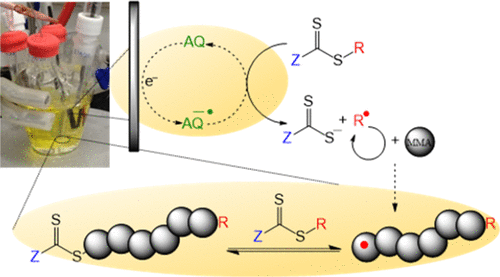当前位置:
X-MOL 学术
›
Macromolecules
›
论文详情
Our official English website, www.x-mol.net, welcomes your
feedback! (Note: you will need to create a separate account there.)
Anthraquinone-Mediated Reduction of a Trithiocarbonate Chain-Transfer Agent to Initiate Electrochemical Reversible Addition–Fragmentation Chain Transfer Polymerization
Macromolecules ( IF 5.1 ) Pub Date : 2020-11-25 , DOI: 10.1021/acs.macromol.0c02392 Lisa T. Strover 1 , Almar Postma 1 , Michael D. Horne 2 , Graeme Moad 1
Macromolecules ( IF 5.1 ) Pub Date : 2020-11-25 , DOI: 10.1021/acs.macromol.0c02392 Lisa T. Strover 1 , Almar Postma 1 , Michael D. Horne 2 , Graeme Moad 1
Affiliation

|
A goal in applying electrochemical methods to reversible addition–fragmentation chain transfer (RAFT) polymerization is to use electrochemical reduction to activate RAFT agents (S═C(Z)S-R) to also act as initiators. The use of a mediator can limit side reactions that would otherwise inhibit polymerization. In this work, we present the use of anthraquinone (AQ) to mediate the electrochemical reduction of a trithiocarbonate RAFT agent, 4-cyano-4-(((dodecylthio)carbonothioyl)thio)pentanoic acid, and thereby initiate RAFT polymerization of methyl methacrylate (MMA). In a representative eRAFT reaction conducted in DMSO with a target degree of polymerization (DP) of 100, conversion reached 67% in 24 h at ambient temperature, with Đ = 1.19. The effect of reaction conditions on polymerization was studied—in general, the conversion rate was found to decrease as target DP increases. Dispersity increases as (i) target DP increases and (ii) mediator concentration increases. The livingness of AQ-mediated eRAFT polymerization was confirmed by eRAFT chain extension with MMA and by thermally initiated RAFT with styrene to form a block copolymer. AQ-mediated eRAFT was found to be unsuitable for polymerization of monosubstituted monomers (styrene, butyl acrylate, N,N-dimethylacrylamide, and N-vinylpyrrolidone). These results support the hypothesis that mediated electrochemical reduction of RAFT agents can yield an initiating species (R•), although polymerization is strongly dependent on diffusion and fragmentation kinetics.
中文翻译:

蒽醌介导的三硫代碳酸酯链转移剂的还原反应,以引发电化学可逆加成-断裂链转移聚合
将电化学方法应用于可逆加成-断裂链转移(RAFT)聚合的一个目标是使用电化学还原来活化RAFT剂(S═C(Z)SR)并同时充当引发剂。介体的使用可以限制否则会抑制聚合的副反应。在这项工作中,我们目前使用蒽醌(AQ)介导三硫代碳酸盐RAFT剂4-氰基-4-((((十二烷基硫基)羰基硫酰基)硫代)戊酸的电化学还原,从而引发甲基丙烯酸甲酯的RAFT聚合(MMA)。在用DMSO(DP)的100目标聚合度进行了代表eRAFT反应,转化在环境温度下在24小时达到67%,与Đ= 1.19。研究了反应条件对聚合的影响,通常发现转化率随目标DP的增加而降低。分散度随着(i)目标DP的增加和(ii)介体浓度的增加而增加。AQ介导的eRAFT聚合反应的活性通过MMA的eRAFT扩链以及与苯乙烯的热引发RAFT形成嵌段共聚物来证实。发现AQ介导的eRAFT不适合单取代单体(苯乙烯,丙烯酸丁酯,N,N-二甲基丙烯酰胺和N-乙烯基吡咯烷酮)的聚合。这些结果支持以下假设,即介导的RAFT试剂的电化学还原可产生引发物种(R •),尽管聚合反应在很大程度上取决于扩散和断裂动力学。
更新日期:2020-12-08
中文翻译:

蒽醌介导的三硫代碳酸酯链转移剂的还原反应,以引发电化学可逆加成-断裂链转移聚合
将电化学方法应用于可逆加成-断裂链转移(RAFT)聚合的一个目标是使用电化学还原来活化RAFT剂(S═C(Z)SR)并同时充当引发剂。介体的使用可以限制否则会抑制聚合的副反应。在这项工作中,我们目前使用蒽醌(AQ)介导三硫代碳酸盐RAFT剂4-氰基-4-((((十二烷基硫基)羰基硫酰基)硫代)戊酸的电化学还原,从而引发甲基丙烯酸甲酯的RAFT聚合(MMA)。在用DMSO(DP)的100目标聚合度进行了代表eRAFT反应,转化在环境温度下在24小时达到67%,与Đ= 1.19。研究了反应条件对聚合的影响,通常发现转化率随目标DP的增加而降低。分散度随着(i)目标DP的增加和(ii)介体浓度的增加而增加。AQ介导的eRAFT聚合反应的活性通过MMA的eRAFT扩链以及与苯乙烯的热引发RAFT形成嵌段共聚物来证实。发现AQ介导的eRAFT不适合单取代单体(苯乙烯,丙烯酸丁酯,N,N-二甲基丙烯酰胺和N-乙烯基吡咯烷酮)的聚合。这些结果支持以下假设,即介导的RAFT试剂的电化学还原可产生引发物种(R •),尽管聚合反应在很大程度上取决于扩散和断裂动力学。







































 京公网安备 11010802027423号
京公网安备 11010802027423号